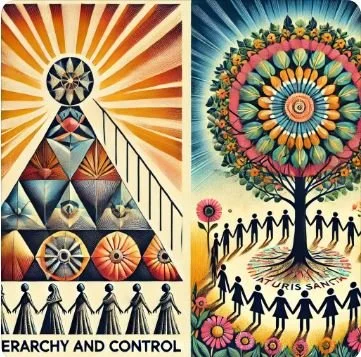Other Religions vs. Naturis Sancta: A Revolution in Spiritual Organisation
Hierarchy and Control: A Feature of Many Other Religions
In many established religions, hierarchical structures dominate the spiritual landscape. These systems, while often rooted in tradition, can inadvertently create barriers to individual empowerment and genuine connection. Characteristics of this approach include:
Centralised Authority: Decisions and interpretations often rest in the hands of a few high-ranking leaders, such as clergy, imams, or other religious elites, who hold the ultimate power to guide followers.
Restricted Access to Leadership: Only select individuals, often chosen by gender, lineage, or training, are permitted to lead, leaving many voices unheard.
Top-Down Control: Policies, rituals, and teachings are typically disseminated from the top of the hierarchy, with little input from the broader community.
Enforcement of Conformity: Strict adherence to the rules and doctrines set by the leadership is expected, discouraging deviation or individual expression.
Sense of Disempowerment: Followers are often relegated to passive roles, dependent on leaders for spiritual guidance, interpretation, and approval.
This hierarchical model can foster a sense of separation between spiritual leaders and their communities, creating an environment where control outweighs collaboration.
Equality and Participation: The Vision of Naturis Sancta
Naturis Sancta rejects rigid hierarchies in favour of a decentralised and inclusive approach that values equality, collaboration, and collective growth. Its organisational principles are built on:
Shared Responsibility: Leadership within Naturis Sancta is not about control but guidance. The community plays an active role in shaping the movement, with all members invited to contribute their insights and ideas.
Accessible Leadership: Regional councils, such as the Light Bearers Council, are designed to represent the collective voices of members, ensuring that leadership reflects the diversity of the community.
Flat Organisational Structure: While councils exist to provide structure, decisions are made collectively, fostering a sense of shared ownership and accountability.
Celebration of Diversity: Everyone, regardless of background, gender, or experience, is encouraged to participate and lead in ways that align with their strengths and passions.
Empowerment through Involvement: Members are not passive observers but active participants in rituals, discussions, and decisions, ensuring a dynamic and evolving spiritual experience.
Connection over Control: Leadership in Naturis Sancta is about facilitating connection—with Nature, with others, and with oneself—rather than enforcing conformity.
This approach ensures that everyone in Naturis Sancta feels valued, heard, and empowered to contribute to the community's spiritual growth.
Visual Contrast: Hierarchy vs. Equality
To bring this contrast to life visually, imagine two symbolic settings:
Hierarchy and Control: A towering pyramid, with a small group at the top and many at the base, symbolising the concentration of power and limited opportunities for engagement.
Equality and Participation: A circle of people gathered in an open field, symbolising unity, shared purpose, and equal standing. The circle is open, inviting new members to join and contribute.
An Invitation to Participate
Naturis Sancta believes that spirituality is a collective journey, not a solitary path dictated by a few. By replacing hierarchies with councils and control with participation, Naturis Sancta offers a framework where every voice matters, and every contribution shapes the future of the movement.
Are you ready to join a spiritual community built on equality, participation, and shared growth?
